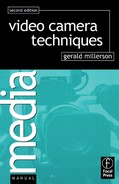Rehearsals are important! It is the production team’s opportunity to judge whether their ideas and organization are going to work out. The director wants to check action, performance, shots, sound, lighting, staging and the various other contributory elements as fully as possible.
Some situations simply can’t be rehearsed – because the performers will not be arriving before the recording session, or you are shooting a once-only event, or because the situation is quite unpredictable (especially where animals or children are involved!). However, instead of just positioning cameras and hoping, an experienced director devises a flexible plan of campaign that will cover the best options, and can be adapted as circumstances allow.
Many forms of production such as interviews or panel games, follow such a familiar pattern, that the director just outlines the general format of the show, and briefly indicates the coverage of each camera.
A few simple precautions can ensure that presentation is smooth-flowing. Let’s imagine that a group of politicians is going to be questioned by members of a studio audience. If everyone is allowed to talk at random, the camera and sound crews are going to spend a lot of time searching around to locate each speaker. By the time cameras and microphone have reached them, they may have finished! Wherever possible therefore, it is better if people speak in an order agreed beforehand, or give a clear signal before joining in.
It helps too, if speakers or characters in a show are clearly identified for the team. It is embarrassing to be asked for a close-up of Jo, only to find that you’ve picked Joe by mistake!
There are two general methods of tackling unrehearsed action:
• Allocating particular types of shot; e.g. Camera 1 takes wide shots (cover shots) of the area, while Camera 2 concentrates on closer shots as they become available.
• A director isolated in the production control room, may have to rely on the initiative of camera operators to see shot opportunities from their viewpoints. These off-the-cuff ‘grab shots’ can be quite successful, as long as cameras do not just concentrate on items that interest them. A series of shots of the visiting celebrity, with none showing the studio audience’s reactions, would be very limiting.
The best technique for grab shots, is take a close shot of a possible area to prefocus your zoom, then zoom out to a wide view. Look around outside your viewfinder, checking for potential subjects. When you see appropriate action, zoom in for the director to assess it.
Area coverage
Cameras may concentrate on certain areas, ready for action there.

Localized coverage
Cameras may concentrate on certain types of shot, moving to fresh areas as directed.

Unexpected action
By checking general action outside your shot, you can see if you are missing any important action.

